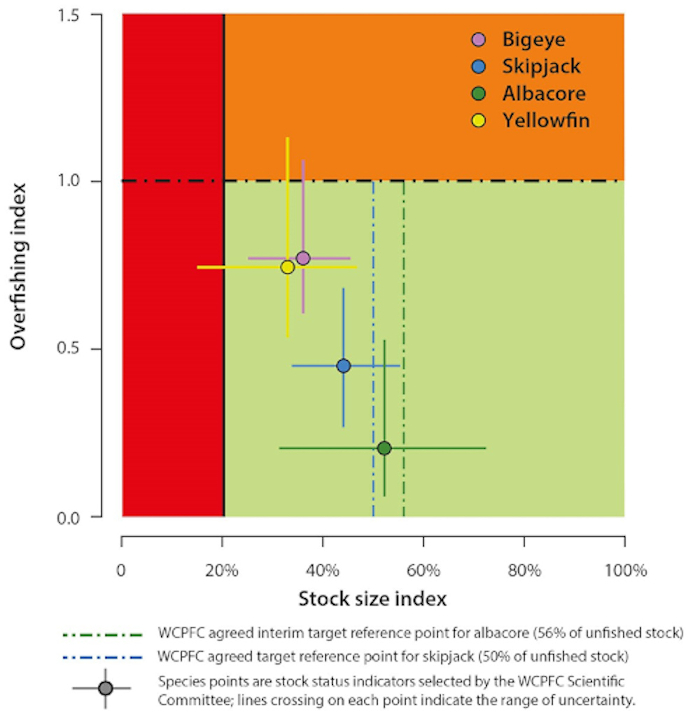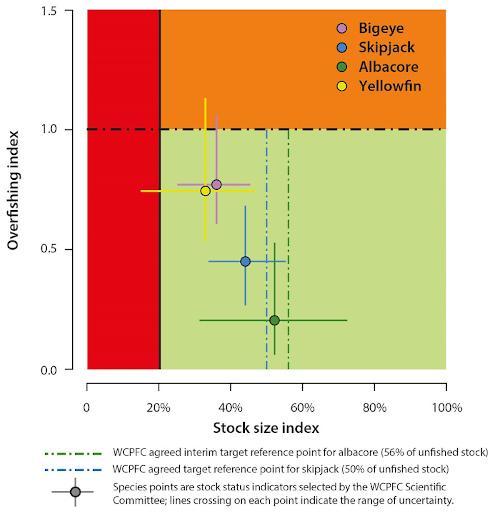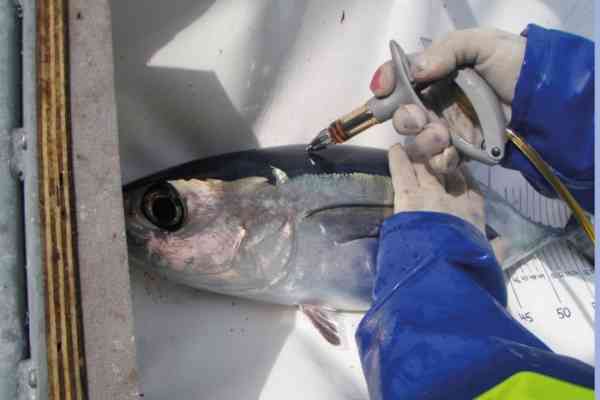(disponible en anglais uniquement)
Lors de cette session, la CPS, en collaboration avec l’Agence des pêches du Forum des Îles du Pacifique, a présenté les dernières données sur les prises de thonidés dans le Pacifique occidental et central. Les premières estimations pour 2018 s’élèvent à plus de 2,7 millions de tonnes, pour une valeur marchande légèrement supérieure à 6 milliards de dollars des États-Unis d’Amérique.
Ground-breaking science at the 15th meeting of the WCPFC Scientific Committee
Representatives from countries across and beyond the Pacific met this August in Pohnpei, Federated States of Micronesia for the 15th Regular Session of the Scientific Committee (SC) of the Western and Central Pacific Fisheries Commission (WCPFC). At this meeting, delegates review the latest science relevant to the management of migratory species in the western and central Pacific Ocean (WCPO), and make formal recommendations to the WCPFC meeting held in December each year. This is the big meeting for the scientific team of the Oceanic Fisheries Programme (OFP) of the Pacific Community (SPC). OFP is the WCPFC’s scientific and data management services provider. The OFP papers and presentations to this meeting provide the backbone for important discussions on the scientific aspects of the largest tuna fishery in the world. It is also the key pathway through which OFP’s work translates into concrete outputs for Pacific Island communities. The OFP team was heavily involved in presentations and working groups for all four themes reviewed by the SC: data and statistics; stock status; management issues; and ecosystems and bycatch mitigation.
SPC – in collaboration with the Pacific Islands Forum Fisheries Agency – provided the latest tuna catch information for the WCPO. The provisional tuna catch for 2018 was estimated at over 2.7 million tonnes, with a delivered value of just over USD 6 billion. This catch level was the second highest on record, and represented just over 80% of the total Pacific Ocean catch and 55% of the global tuna catch. Given the impact of our new knowledge on bigeye growth on the estimated status of this stock, there has been great interest in improving our understanding of the biology of all tuna stocks in the WCPO. The latest ageing results developed in collaboration with the Commonwealth Scientific and Industrial Research Organisation in Australia for both bigeye and yellowfin tuna were presented to this meeting of the SC. While there is still more work to be done, this new information will feed into new assessments of both of these stocks that are scheduled for next year.
This year, new stock assessments were presented by SPC for WCPO skipjack, southwest Pacific striped marlin, and WCPO oceanic whitetip shark.

The skipjack assessment benefited from a new understanding of the stock’s biology that was provided by Japanese colleagues. Similar to bigeye tuna last year, this changed our perception of the status of the stock slightly, but it continues to be in the ‘green zone’ of our ‘Majuro plot’ (i.e. not overfished, and not subject to overfishing) (Fig. 1). This assessment will form the basis for further work in 2019 to inform the WCPFC as to whether the interim target reference point for the stock (the level the stock should be at to achieve what managers want from the fishery) should be adjusted.
The southwest Pacific striped marlin assessment presented this year was the first performed since 2012. Across the range of models examined within this year’s assessment, over two-thirds indicated that the stock was overfished, although more than half of the models indicated that overfishing has not been occurring recently. The potential management actions required for this stock, including the enhancement of the current management measure, will form part of discussions at the 16th meeting of the WCPFC in December.
The oceanic whitetip shark assessment, led by the New Zealand consultancy Dragonfly, indicated that the stock was below most management benchmarks. Management measures are currently in place for this stock aimed at reducing fishing impacts. While the assessment suggests these are having a beneficial impact, further work has been identified to examine whether the measure is sufficient to allow stock recovery.
In the discussions on management issues, SPC scientists presented work to support the ‘harvest strategy’ approach to tuna stocks. This approach focuses on longer-term objectives for fisheries and stocks, and aims to move away from annual short-term decision-making. This work is ongoing, and the latest developments in the framework for skipjack and South Pacific albacore were presented. A key future development is a consideration of the consequences of managing the fisheries of one stock on other stocks caught in the WCPO. This ‘multispecies’ issue was the focus of two different SPC papers, which highlighted the interactions that need to be taken into account when developing both target reference points for bigeye and yellowfin tuna stocks, and when developing harvest strategies for these stocks and key fisheries.
Two SPC-led analyses related to fish aggregation devices (FADs) in the WCPO were presented. The first, in collaboration with the Parties to the Nauru Agreement (PNA), evaluated the latest information from the PNA FAD tracking programme. It presented the spatial pattern of FADs, whether areas of higher FAD densities had different tuna catch rates, and the fate of FADs, particularly those that drifted outside the main fishing grounds of the companies that owned them and eventually beached on shorelines or coral reefs. The second, in collaboration with industry partners Tri Marine and South Pacific Tuna Corporation, presented preliminary analyses of the patterns of tuna aggregation below FADs, as estimated by echosounders fitted to drifting FADs. Echosounder use on FADs is now widespread throughout the fishery, and has the potential to provide novel and valuable information for scientific analyses. Insights into the pattern and rate at which tunas may aggregate around newly deployed FADs, trends just prior to fishing set events, and the spatial pattern of biomass estimates were presented for the first time.
Ongoing tagging of tuna around FADs, to examine how long individuals remain around FADs and their behaviour while they remained there, has begun to identify some of these patterns in relation to factors that influence tuna aggregations such as local FAD density, moon phase and time of day at the FAD. This exciting work has already provided some interesting results that may help identify new mitigation measures for the catches of small bigeye and yellowfin in sets around FADs.
Finally, reflecting the fact that target tuna are not the only marine species caught during fishing operations, we developed estimates of annual seabird mortality using the latest information collected by regional observers. Bycatch estimates in the purse-seine fishery were very low (approximately one mortality per year). In longline fisheries, for which mortality estimates were higher, the spatial pattern of incidences was examined for the most recent years, where enough observer information was available. Increasing the coverage of observers on longline vessels would help improve these calculations and highlight approaches to further reduce impacts.
In addition to SPC’s work, contributions were also presented by our scientific colleagues who work across the Pacific, including an assessment for North Pacific striped marlin by the International Scientific Committee for Tuna and Tuna-like Species in the North Pacific Ocean, alternative assessment approaches for sharks by Dragonfly Consulting, estimates of shark release mortality by the United States, and a report from a workshop on the issue by the Areas Beyond National Jurisdiction project, work on biodegradable FAD designs and ecosystem indicators by the European Union, and safe release guidelines for birds developed by New Zealand scientists.
Next year’s proposed assessments for SPC include bigeye and yellowfin tuna. Further work for OFP in 2019 includes the WCPFC’s Technical and Compliance Committee (TCC) meeting, and the WCPFC meeting to be held in Port Moresby in December, where the SC’s and TCC’s recommendations are reviewed and translated into actual management measures and regulations.
For more information:
Visit FAME website
Download the PDF
Contact:
Graham Pilling, Deputy Director FAME, Oceanic Fisheries Programme | [email protected]

